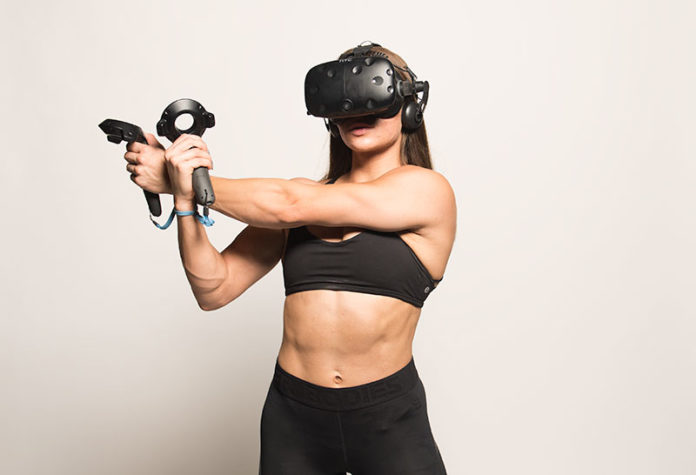Every athlete strives to make the most of a workout session while minimizing injury. Injury time gets worse as we age, and especially as we’re working on our fitness plans. Those first few months of getting back in shape are prone to injury, which kills momentum, ultimately stalling your goals for the year.
VR fitness is no exception. The full-body experiences you get in BoxVR or Synth Riders can lead to injury for users who go too hard. First, identify your limits using difficulty as a good gauge. Harder games in VR aren’t just more challenging; they are often physically far more demanding.
Next, focus on these tips to help prevent and minimize your injuries in VR.
Tip 1 | Clear Proper Space
VR thrives when you can move, twist, turn, dodge, and squat without hitting anything or tripping over anything. Step one is to push bookcases and furniture further out of your play zone. Then focus on dealing with the cord for your headset.
Can you raise the cord for your headset? Adhesive hooks are a great option for apartment dwellers or those who don’t want to drill into walls. A few mounted to one wall to raise the cord should be enough for a better experience without the cable dragging around your feet.
I haven’t found a rigging system I like yet, but if one exists, I’ll be sure to update the community. Any advice is welcome here.
Tip 2 | Warm the Proper Muscles
Make your warmup count by warming up the right muscles. Stretching literally warms (begins the workout) for your muscle groups, like easing into your routine. Most of the games I spend time playing work my shoulders, arms, and core.
I focus on these areas with my stretches to get the best benefit out of my warmup. I also stretch on off days, so I’m limber. Stretch in the morning before work, and in the evening either right after work or just before bed. Keep it basic by touching your toes or doing some calf stretches. The goal is to release tension you’ve built up while you slept or work.

I also recommend some yoga if you’re feeling up for it. It’s easy to do when you watch TV at night, even those of us with kids, and they feel very relaxing after the first few days of learning the poses.
Tip 3 | Take Breaks
The key to endurance is simple: pacing. You need to know how to pace yourself for longevity. We advise using naturally occurring breaks in VR to fit in a squat or a stretch. Try to time your breaks to around two minutes at the maximum. This way, you’re not regaining all the fitness intensity you lose taking an extended break.
VRs loading screens and pacing are naturally great for this kind of session. Skyrim is a good example, where the user can punctuate extended combat with short breaks between each skirmish. Try to make sure you’re in an encounter at least every two minutes.
Tip 4 | Scale Your Intensity
As you tackle tougher difficulties and challenges, you gain strength and get fitter. You’ll also plateau if you’re not finding new ways to push yourself and your fitness. This is where many workouts end: we see physical gains, and we stop.
The truth is that these are just the early gains. To get to the top, you need to learn how to challenge yourself beyond the limitations of the game. In BoxVR, you may need to seek out a specific playlist built around squats or aggressive moves. You may need to mod BeatSaber and practice.
[youtube https://www.youtube.com/watch?v=yFSl9QoYZIs&w=560&h=315]
You might also try multiplayer, where you can fight against other human opponents and show off what you’ve learned. Multiplayer fighting games are a different kind of challenge. Dodging and finding openings in a live opponent requires staying aggressive. Already heart-thumping experiences like Creed or Sprint Vector are made even better with live opponents.
Tip 5 | Log Your Sessions
One of the reasons we suggest a fitness journal is to help you commit. When you write something down, you commit to it, and it becomes a goal or a task to complete. It’s easier to hold yourself accountable when you have a to-do list.
We advise that you log your calorie counts, but a more relaxed and still effective means of controlling your diet is to record every cheat meal. From experience, I can tell you it’s not fun looking at how many times you hit fast food or snacks in a week. You can help yourself stay consistently healthier with this alternative to logging every meal.
Tip 6 | Upgrade Your Shoes
Your shoes impact your footing, and the pressure and strain you put on your legs. If you’re serious about VR fitness, invest in new shoes that absorb the rapid movements you make in VR. Good shoes for VR include running shoes or shoes with a minimal arch.
You should also avoid any surfaces that bunch up or any that feel slick to the touch. No playing in socks or sandals either.
Tip 7| Hydrate!
The final tip is a simple one: hydrate. We can lose up to 2% of our body weight in water through sweat during a workout. Replace that lost water and regulate your body temperature.
I love the 32 oz Nalgene bottle for hydration. Easy to refill, stylish colors, and useful on half day hikes or days outside.
Final Thoughts
When you prepare the muscles, hydrate to regular your body temperature, and ensure your space is hazard free, you go a long way toward preventing fitness-related injuries in VR. Remember to utilize your downtime effectively, giving your muscles just the right amount of time to heal before getting back into the game.



